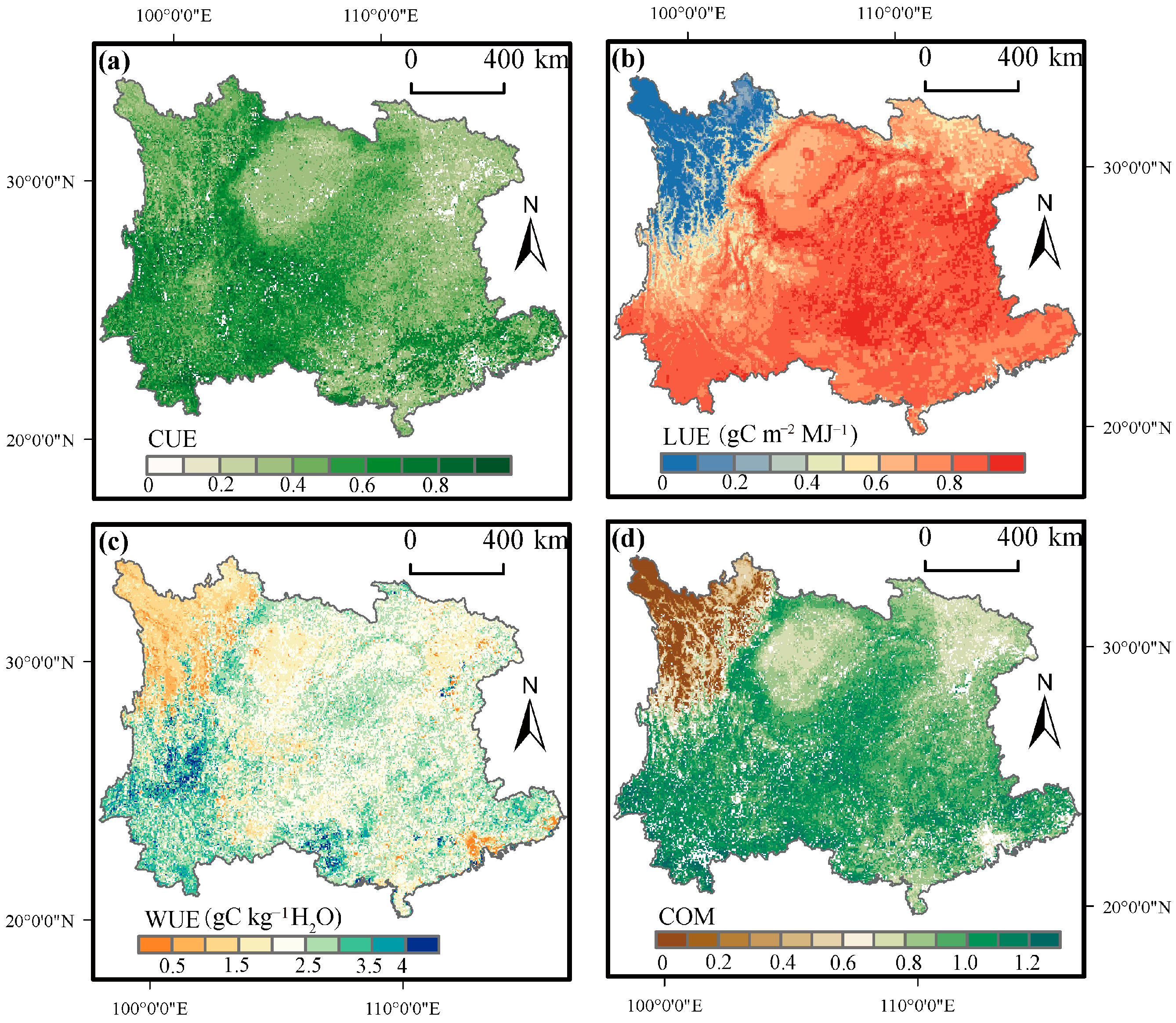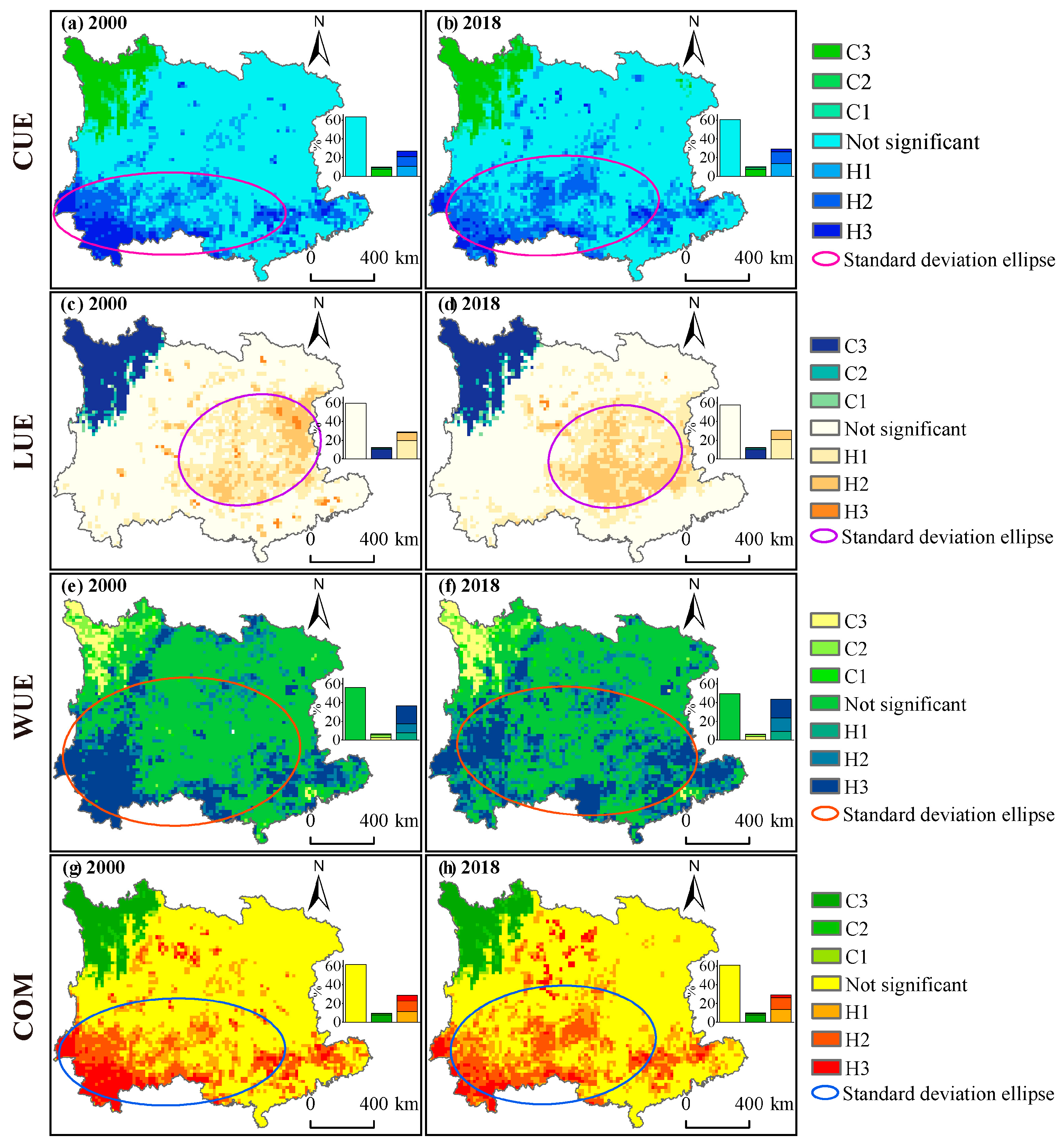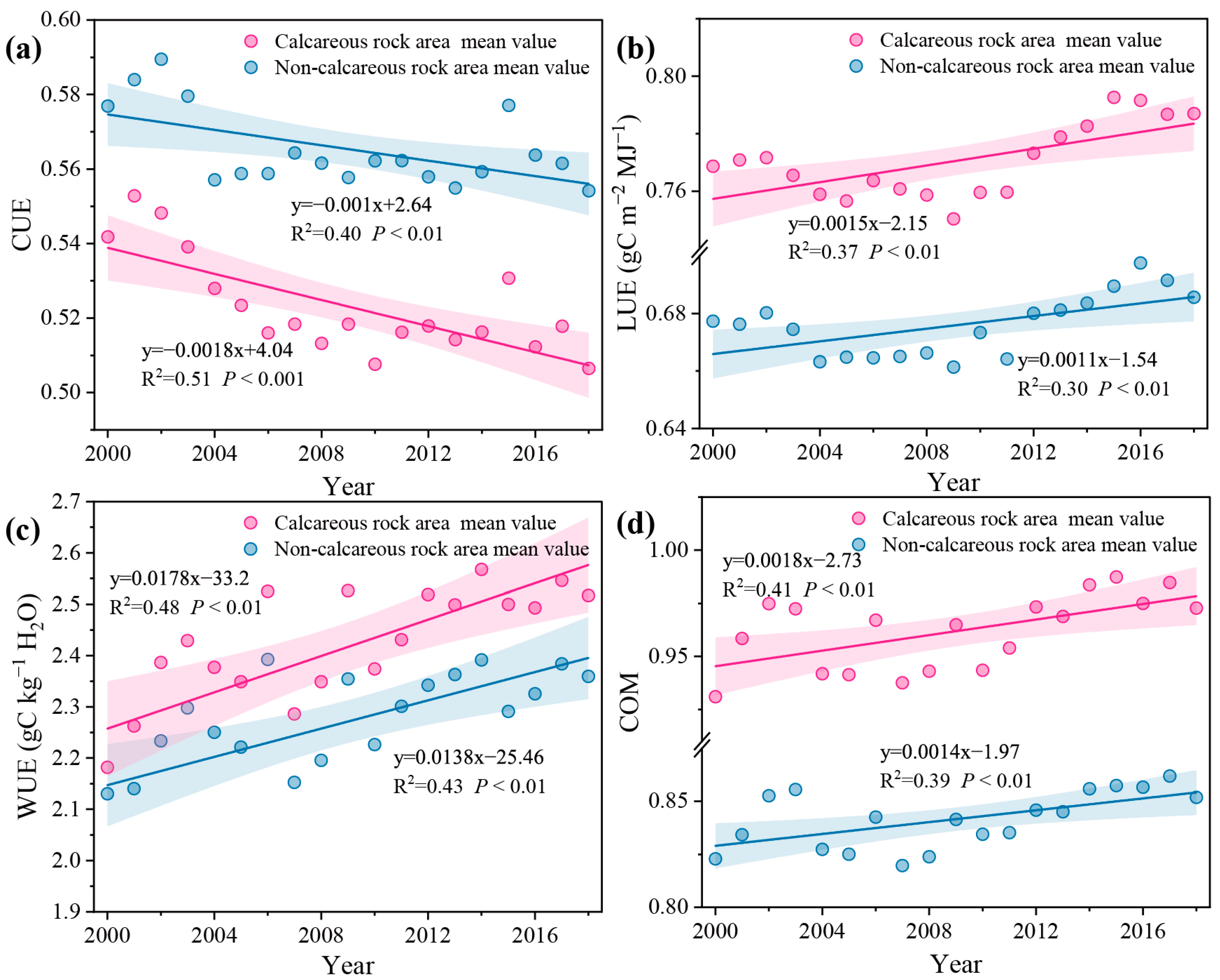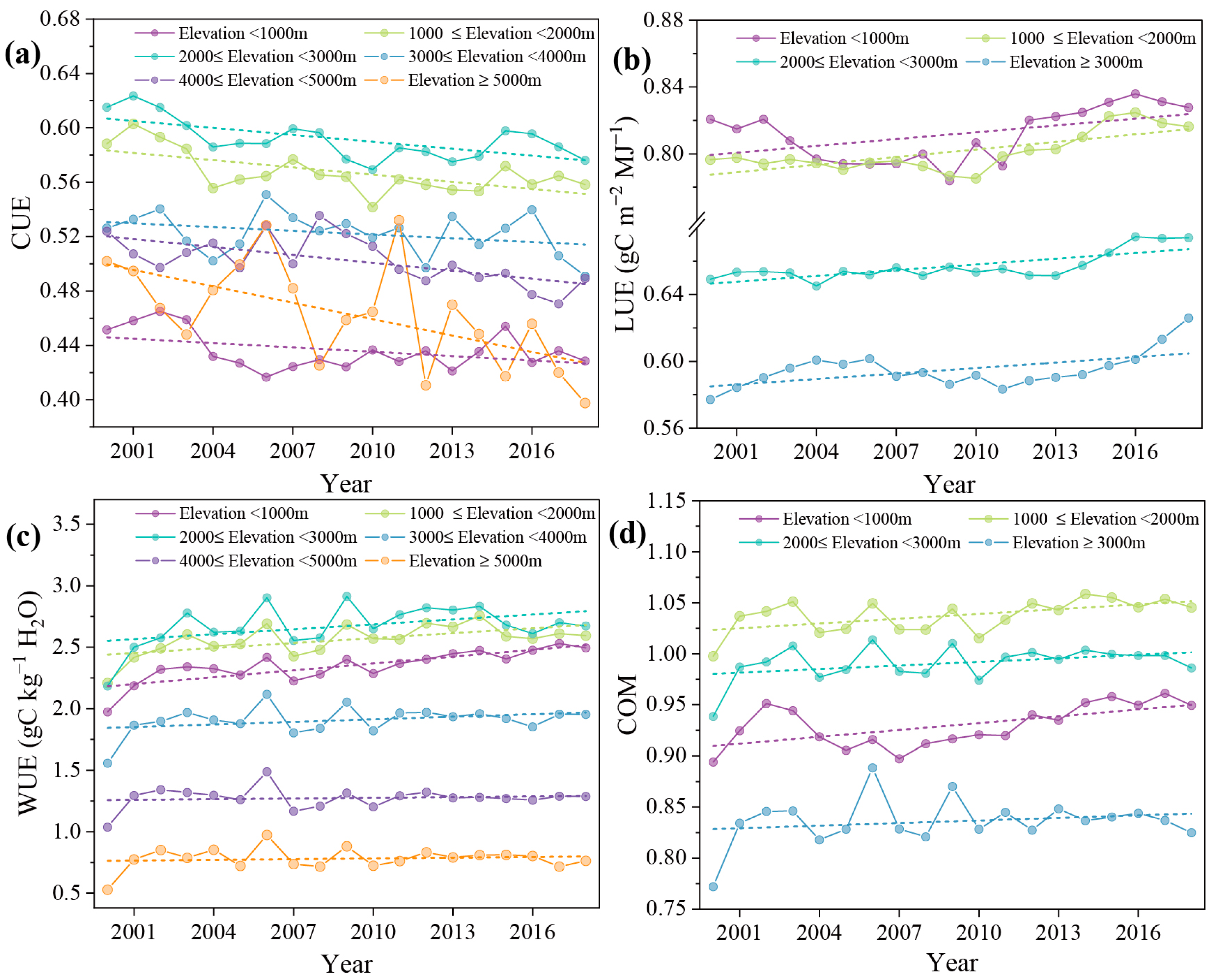Driving Forces and Ecological Restoration Revelation in Southwest China Based on the Divergence Characteristics of Ecosystem Compound Use Efficiency
Abstract
:1. Introduction
2. Materials and Methods
2.1. Study Area
2.2. Data
2.2.1. Gross Primary Productivity (GPP), Net Primary Productivity (NPP), and Normalized Difference Vegetation Index (NDVI) Data
2.2.2. The Climate Factor Data
2.2.3. Vegetation and Land Use Data
2.2.4. Additional Data
2.3. Methods
2.3.1. CUE, LUE, WUE, and COM Calculations
2.3.2. Hotspot Analysis
2.3.3. GeoData Spatial Autocorrelation Analysis
2.3.4. The Driving Forces of Spatial Heterogeneity Analysis
2.3.5. Ecological Restoration Area Identification
2.3.6. Land Use Degree Comprehensive Index (LDCI)
3. Results
3.1. Spatiotemporal Trends of Ecosystem CUE, LUE, WUE, and COM in Southwest China
3.2. The Hotspots and Spatial Autocorrelation Characteristics Analysis
3.3. Divergence Characteristics Analysis under Different Background Conditions
3.4. Driving Force Detection of the COM in Southwest China
3.4.1. Selection of the Optimal COM Analysis Scale
3.4.2. Independent and Interactive Effects of Driving Forces on the COM
3.4.3. Interaction of Driving Factors for COM Divergence
4. Discussion
4.1. Trade-Offs/Synergies among Water–Carbon–Light Use Efficiencies
4.2. Ecological Restoration Enlightenment Based on Divergent Characteristics
4.3. Impact of Temperature, Elevation, and Coupling Factor on COM
4.4. Limitations and Perspectives of This Study
5. Conclusions
Supplementary Materials
Author Contributions
Funding
Data Availability Statement
Conflicts of Interest
References
- Huang, M.T.; Piao, S.L.; Sun, Y.; Ciais, P.; Cheng, L.; Mao, J.F.; Wang, Y.P. Change in terrestrial ecosystem water-use efficiency over the last three decades. Glob. Chang. Biol. 2015, 21, 2366–2378. [Google Scholar] [CrossRef] [PubMed]
- Keenan, T.F.; Hollinger, D.Y.; Bohrer, G.; Dragoni, D.; Munger, J.W.; Schmid, H.P.; Richardson, A.D. Increase in forest water-use efficiency as atmospheric carbon dioxide concentrations rise. Nature 2013, 499, 324–327. [Google Scholar] [CrossRef]
- Xiao, B.Q.; Bai, X.Y.; Zhao, C.W.; Tan, Q.; Li, Y.B.; Luo, G.J.; Du, C.C. Responses of carbon and water use efficiencies to climate and land use changes in China’s karst areas. J. Hydrol. 2023, 617, 13. [Google Scholar] [CrossRef]
- Bradford, M.A.; Crowther, T.W. Carbon use efficiency and storage in terrestrial ecosystems. New Phytol. 2013, 199, 7–9. [Google Scholar] [CrossRef] [PubMed]
- Hou, G.; Sun, J.; Wang, J.N. Dynamics and Controls of Carbon Use Efficiency across China’s Grasslands. Pol. J. Environ. Stud. 2018, 27, 1541–1550. [Google Scholar] [CrossRef] [PubMed]
- Wang, L.M.; Li, M.Y.; Wang, J.X.; Li, X.G.; Wang, L.C. An analytical reductionist framework to separate the effects of climate change and human activities on variation in water use efficiency. Sci. Total Environ. 2020, 727, 15. [Google Scholar] [CrossRef] [PubMed]
- Xue, Y.Y.; Liang, H.B.; Zhang, B.Q.; He, C.S. Vegetation restoration dominated the variation of water use efficiency in China. J. Hydrol. 2022, 612, 14. [Google Scholar] [CrossRef]
- Gitelson, A.A.; Gamon, J.A. The need for a common basis for defining light-use efficiency: Implications for productivity estimation. Remote Sens. Environ. 2015, 156, 196–201. [Google Scholar] [CrossRef]
- Pangle, L.; Vose, J.M.; Teskey, R.O. Radiation use efficiency in adjacent hardwood and pine forests in the southern Appalachians. For. Ecol. Manag. 2009, 257, 1034–1042. [Google Scholar] [CrossRef]
- Fei, X.H.; Song, Q.H.; Zhang, Y.P.; Yu, G.R.; Zhang, L.M.; Sha, L.Q.; Grace, J. Patterns and Controls of Light Use Efficiency in Four Contrasting Forest Ecosystems in Yunnan, Southwest China. J. Geophys. Res. Biogeosciences 2019, 124, 293–311. [Google Scholar] [CrossRef]
- Flexas, J.; Barbour, M.M.; Brendel, O.; Cabrera, H.M.; Carriquí, M.; Díaz-Espejo, A.; Warren, C.R. Mesophyll diffusion conductance to CO2: An unappreciated central player in photosynthesis. Plant Sci. 2012, 193, 70–84. [Google Scholar] [CrossRef] [PubMed]
- Piao, S.; Friedlingstein, P.; Ciais, P.; de Noblet-Ducoudré, N.; Labat, D.; Zaehle, S. Changes in climate and land use have a larger direct impact than rising CO2 on global river runoff trends. Proc. Natl. Acad. Sci. USA 2007, 104, 15242–15247. [Google Scholar] [CrossRef] [PubMed]
- Wang, J.; Wen, X.F.; Zhang, X.Y.; Li, S.G. The strategies of water-carbon regulation of plants in a subtropical primary forest on karst soils in China. Biogeosciences 2018, 15, 4193–4203. [Google Scholar] [CrossRef]
- Zhang, J.; Yang, S.Q.; Yang, S.T.; Fan, L.; Zhou, X. Spatio-Temporal Variations of Ecosystem Water Use Efficiency and Its Drivers in Southwest China. Land 2023, 12, 397. [Google Scholar] [CrossRef]
- Geekiyanage, N.; Goodale, U.M.; Cao, K.F.; Kitajima, K. Plant ecology of tropical and subtropical karst ecosystems. Biotropica 2019, 51, 626–640. [Google Scholar] [CrossRef]
- Zhang, Y.J.; Yu, G.R.; Yang, J.; Wimberly, M.C.; Zhang, X.Z.; Tao, J.; Zhu, J.T. Climate-driven global changes in carbon use efficiency. Glob. Ecol. Biogeogr. 2014, 23, 144–155. [Google Scholar] [CrossRef]
- Piao, S.; Luyssaert, S.; Ciais, P.; Janssens, I.A.; Chen, A.; Cao, C.; Wang, S. Forest annual carbon cost: A global-scale analysis of autotrophic respiration. Ecology 2010, 91, 652–661. [Google Scholar] [CrossRef] [PubMed]
- Qu, R.; Han, G.L. Effects of high Ca and Mg stress on plants water use efficiency in a Karst ecosystem. PeerJ 2022, 10, 14. [Google Scholar] [CrossRef] [PubMed]
- Si, J.H.; Feng, Q.; Yu, T.F.; Zhao, C.Y.; Li, W. Variation in populus euphratica foliar carbon isotope composition and osmotic solute for different groundwater depths in an arid region of China. Environ. Monit. Assess. 2015, 187, 15. [Google Scholar] [CrossRef]
- Zhang, S.B.; Zhang, J.L.; Slik, J.W.F.; Cao, K.F. Leaf element concentrations of terrestrial plants across China are influenced by taxonomy and the environment. Glob. Ecol. Biogeogr. 2012, 21, 809–818. [Google Scholar] [CrossRef]
- Ding, Z.; Liu, Y.; Wang, L.C.; Chen, Y.A.; Yu, P.J.; Ma, M.G.; Tang, X.G. Effects and implications of ecological restoration projects on ecosystem water use efficiency in the karst region of Southwest China. Ecol. Eng. 2021, 170, 9. [Google Scholar] [CrossRef]
- Gao, Y.; Zhu, X.J.; Yu, G.R.; He, N.P.; Wang, Q.F.; Tian, J. Water use efficiency threshold for terrestrial ecosystem carbon sequestration in China under afforestation. Agric. For. Meteorol. 2014, 195, 32–37. [Google Scholar] [CrossRef]
- Zhang, M.Y.; Wang, K.L.; Liu, H.Y.; Wang, J.; Zhang, C.H.; Yue, Y.M.; Qi, X.K. Spatio-Temporal Variation and Impact Factors for Vegetation Carbon Sequestration and Oxygen Production Based on Rocky Desertification Control in the Karst Region of Southwest China. Remote Sens. 2016, 8, 102. [Google Scholar] [CrossRef]
- Hou, Y.; Li, B.; Müller, F.; Fu, Q.; Chen, W.P. A conservation decision-making framework based on ecosystem service hotspot and interaction analyses on multiple scales. Sci. Total Environ. 2018, 643, 277–291. [Google Scholar] [CrossRef]
- Rabe, S.E.; Koellner, T.; Marzelli, S.; Schumacher, P.; Grêt-Regamey, A. National ecosystem services mapping at multiple scales—The German exemplar. Ecol. Indic. 2016, 70, 357–372. [Google Scholar] [CrossRef]
- Han, R.Y.; Wang, Z.H.; Shen, Y.Y.; Wu, Q.X.; Liu, X.M.; Cao, C.; Zhang, J. Anthropogenic Gd in urban river water: A case study in Guiyang, SW China. Elementa Sci. Anthrop. 2021, 9, 13. [Google Scholar] [CrossRef]
- Yue, Y.; Wang, K.; Zhang, B.; Jiao, Q.; Liu, B.; Zhang, M. Remote sensing of fractional cover of vegetation and exposed bedrock for karst rocky desertification assessment. Procedia Environ. Sci. 2012, 13, 847–853. [Google Scholar] [CrossRef]
- Chen, Y.J.; Cao, K.F.; Schnitzer, S.A.; Fan, Z.X.; Zhang, J.L.; Bongers, F. Water-use advantage for lianas over trees in tropical seasonal forests. New Phytol. 2015, 205, 128–136. [Google Scholar] [CrossRef] [PubMed]
- Nie, Y.P.; Chen, H.S.; Wang, K.L.; Ding, Y.L. Seasonal variations in leaf δ 13 C values: Implications for different water-use strategies among species growing on continuous dolomite outcrops in subtropical China. Acta Physiol. Plant 2014, 36, 2571–2579. [Google Scholar] [CrossRef]
- Wang, S.J.; Liu, Q.M.; Zhang, D.F. Karst rocky desertification in southwestern China: Geomorphology, landuse, impact and rehabilitation. Land Degrad. Dev. 2004, 15, 115–121. [Google Scholar] [CrossRef]
- Chen, T.T.; Wang, Q.; Wang, Y.X.; Peng, L. Processes and mechanisms of vegetation ecosystem responding to climate and ecological restoration in China. Front. Plant Sci. 2022, 13, 14. [Google Scholar] [CrossRef] [PubMed]
- Peng, L.; Chen, T.T.; Deng, W.; Liu, Y. Exploring ecosystem services trade-offs using the Bayesian belief network model for ecological restoration decision-making: A case study in Guizhou Province, China. Ecol. Indic. 2022, 135, 11. [Google Scholar] [CrossRef]
- Yue, Y.M.; Qi, X.K.; Wang, K.L.; Liao, C.J.; Tong, X.W.; Brandt, M.; Liu, B. Large scale rocky desertification reversal in South China karst. Prog. Phys. Geogr. 2022, 46, 661–675. [Google Scholar] [CrossRef]
- Huang, L.; He, B.; Han, L.; Liu, J.J.; Wang, H.Y.; Chen, Z.Y. A global examination of the response of ecosystem water-use efficiency to drought based on MODIS data. Sci. Total Environ. 2017, 601, 1097–1107. [Google Scholar] [CrossRef] [PubMed]
- Yin, J.B.; Gentine, P.; Slater, L.; Gu, L.; Pokhrel, Y.; Hanasaki, N.; Schlenker, W. Future socio-ecosystem productivity threatened by compound drought-heatwave events. Nat. Sustain. 2023, 6, 259–272. [Google Scholar] [CrossRef]
- Zhang, C.H.; Qi, X.K.; Wang, K.L.; Zhang, M.Y.; Yue, Y.M. The application of geospatial techniques in monitoring karst vegetation recovery in southwest China: A review. Prog. Phys. Geogr. 2017, 41, 450–477. [Google Scholar] [CrossRef]
- Li, P.L.; Zhu, D.; Wang, Y.L.; Liu, D. Elevation dependence of drought legacy effects on vegetation greenness over the Tibetan Plateau. Agric. For. Meteorol. 2020, 295, 12. [Google Scholar] [CrossRef]
- Pan, N.Q.; Feng, X.M.; Fu, B.J.; Wang, S.; Ji, F.; Pan, S.F. Increasing global vegetation browning hidden in overall vegetation greening: Insights from time-varying trends. Remote Sens. Environ. 2018, 214, 59–72. [Google Scholar] [CrossRef]
- Peng, W.F.; Kuang, T.T.; Tao, S. Quantifying influences of natural factors on vegetation NDVI changes based on geographical detector in Sichuan, western China. J. Clean. Prod. 2019, 233, 353–367. [Google Scholar] [CrossRef]
- Chen, J.; Brissette, F.P.; Leconte, R. Uncertainty of downscaling method in quantifying the impact of climate change on hydrology. J. Hydrol. 2011, 401, 190–202. [Google Scholar] [CrossRef]
- Cogswell, A.; Greenan, B.J.W.; Greyson, P. Evaluation of two common vulnerability index calculation methods. Ocean Coast. Manag. 2018, 160, 46–51. [Google Scholar] [CrossRef]
- Liu, Y.; Li, P.; Wang, Y.X.; Xu, X.Y. Quantification of carbon-water dynamics in soil-perennial grass (Bothriochloa ischaemum) feedbacks under drought stress following a double isotope-labelled pulse experiment. Agric. For. Meteorol. 2023, 329, 13. [Google Scholar] [CrossRef]
- Yuan, W.; Liu, S.; Zhou, G.; Zhou, G.; Tieszen, L.L.; Baldocchi, D.; Goulden, M.L. Deriving a light use efficiency model from eddy covariance flux data for predicting daily gross primary production across biomes. Agric. For. Meteorol. 2007, 143, 189–207. [Google Scholar] [CrossRef]
- Xiao, X.M.; Zhang, Q.Y.; Braswell, B.; Urbanski, S.; Boles, S.; Wofsy, S.; Berrien, M.; Ojima, D. Modeling gross primary production of temperate deciduous broadleaf forest using satellite images and climate data. Remote Sens. Environ. 2004, 91, 256–270. [Google Scholar] [CrossRef]
- Yuan, W.P.; Zheng, Y.; Piao, S.L.; Ciais, P.; Lombardozzi, D.; Wang, Y.P.; Yang, S. Increased atmospheric vapor pressure deficit reduces global vegetation growth. Sci. Adv. 2019, 5, 12. [Google Scholar] [CrossRef] [PubMed]
- Dong, J.; Lu, H.B.; Wang, Y.W.; Ye, T.; Yuan, W.P. Estimating winter wheat yield based on a light use efficiency model and wheat variety data. ISPRS J. Photogramm. Remote Sens. 2020, 160, 18–32. [Google Scholar] [CrossRef]
- Getis, A.; Ord, J.K. The analysis of spatial association by use of distance statistics. Geogr. Anal. 1992, 24, 189–206. [Google Scholar] [CrossRef]
- Wan, J.J.; Wang, Z.M.; Ma, C.C.; Su, Y.; Zhou, T.; Wang, T.T.; Tang, X.H. Spatial-temporal differentiation pattern and influencing factors of high-quality development in counties: A case of Sichuan, China. Ecol. Indic. 2023, 148, 17. [Google Scholar] [CrossRef]
- Anselin, L. Local indicators of spatial association-LISA. Geogr. Anal. 1995, 27, 93–115. [Google Scholar] [CrossRef]
- Sun, J.H.; Guo, E.R.; Yang, X.T.; Kong, Y.H.; Yang, L.; Liu, H.; Lin, X.B. Seasonal and spatial variations in soil biochemical properties in areas with different degrees of mining subsidence in Central China. Catena 2023, 224, 15. [Google Scholar] [CrossRef]
- Xiao, R.; Cao, W.; Liu, Y.; Lu, B.B. The impacts of landscape patterns spatio-temporal changes on land surface temperature from a multi-scale perspective: A case study of the Yangtze River Delta. Sci. Total Environ. 2022, 821, 11. [Google Scholar] [CrossRef] [PubMed]
- Zhou, W.; Yang, K.; Bai, Z.K.; Cheng, H.X.; Liu, F. The development of topsoil properties under different reclaimed land uses in the Pingshuo opencast coalmine of Loess Plateau of China. Ecol. Eng. 2017, 100, 237–245. [Google Scholar] [CrossRef]
- Wang, J.F.; Zhang, T.L.; Fu, B.J. A measure of spatial stratified heterogeneity. Ecol. Indic. 2016, 67, 250–256. [Google Scholar] [CrossRef]
- Zhang, K.; Lü, Y.H.; Fu, B.J.; Li, T. The effects of restoration on vegetation trends: Spatiotemporal variability and influencing factors. Earth Environ. Sci. Trans. R. Soc. Edinb. 2019, 109, 473–481. [Google Scholar] [CrossRef]
- He, L.; Guo, J.; Jiang, Q.; Zhang, Z.; Yu, S. How did the Chinese Loess Plateau turn green from 2001 to 2020? An explanation using satellite data. Catena 2022, 214, 106246. [Google Scholar] [CrossRef]
- Yang, L.S.; Feng, Q.; Wen, X.H.; Barzegar, R.; Adamowski, J.F.; Zhu, M.; Yin, Z.L. Contributions of climate, elevated atmospheric CO2 concentration and land surface changes to variation in water use efficiency in Northwest China. Catena 2022, 213, 15. [Google Scholar] [CrossRef]
- Wang, M.; Wang, Y.; Wu, Y.M.; Yue, X.L.; Wang, M.J.; Hu, P.P. Identifying the spatial heterogeneity in the effects of the construction land scale on carbon emissions: Case study of the Yangtze River Economic Belt, China. Environ. Res. 2020, 212, 12. [Google Scholar] [CrossRef] [PubMed]
- Tian, H.J.; Cao, C.X.; Chen, W.; Bao, S.N.; Yang, B.; Myneni, R.B. Response of vegetation activity dynamic to climatic change and ecological restoration programs in Inner Mongolia from 2000 to 2012. Ecol. Eng. 2015, 82, 276–289. [Google Scholar] [CrossRef]
- Guo, L.; Luo, M.; Zhangyang, C.S.; Zeng, C.; Wang, S.Q.; Zhang, H.T. Spatial modelling of soil organic carbon stocks with combined principal component analysis and geographically weighted regression. J. Agric. Sci. 2018, 156, 774–784. [Google Scholar] [CrossRef]
- Zhang, X.M.; Yue, Y.M.; Tong, X.W.; Wang, K.L.; Qi, X.K.; Deng, C.X.; Brandt, M. Eco-engineering controls vegetation trends in southwest China karst. Sci. Total Environ. 2021, 770, 12. [Google Scholar] [CrossRef]
- Zhang, L.X.; Zhou, D.C.; Fan, J.W.; Hu, Z.M. Comparison of four light use efficiency models for estimating terrestrial gross primary production. Ecol. Model. 2015, 300, 30–39. [Google Scholar] [CrossRef]
- Norby, R.J.; Zak, D.R. Ecological Lessons from Free-Air CO2 Enrichment (FACE) Experiments. Annu. Rev. Ecol. Evol. Syst. 2011, 44, 181–203. [Google Scholar] [CrossRef]
- Thomas, R.T.; Prentice, L.C.; Graven, H.; Ciais, P.; Fisher, J.B.; Hayes, D.J.; Zeng, N. Increased light-use efficiency in northern terrestrial ecosystems indicated by CO2 and greening observations. Geophys. Res. Lett. 2016, 43, 11339–11349. [Google Scholar] [CrossRef]
- Wang, M.; Ding, Z.; Wu, C.Y.; Song, L.S.; Ma, M.G.; Yu, P.J.; Tang, X.G. Divergent responses of ecosystem water-use efficiency to extreme seasonal droughts in Southwest China. Sci. Total Environ. 2020, 760, 14. [Google Scholar] [CrossRef]
- Zhang, Q.; Lu, J.X.; Xu, X.X.; Ren, X.Z.; Wang, J.F.; Chai, X.H.; Wang, W.W. Spatial and Temporal Patterns of Carbon and Water Use Efficiency on the Loess Plateau and Their Influencing Factors. Land 2023, 12, 77. [Google Scholar] [CrossRef]
- Tong, X.W.; Wang, K.L.; Brandt, M.; Yue, Y.M.; Liao, C.J.; Fensholt, R. Assessing Future Vegetation Trends and Restoration Prospects in the Karst Regions of Southwest China. Remote Sens. 2016, 8, 357. [Google Scholar] [CrossRef]
- Wang, J.; Wang, K.L.; Zhang, M.Y.; Zhang, C.H. Impacts of climate change and human activities on vegetation cover in hilly southern China. Ecol. Eng. 2015, 81, 451–461. [Google Scholar] [CrossRef]
- Keyimu, M.; Li, Z.S.; Wu, X.C.; Fu, B.J.; Liu, G.H.; Shi, S.L.; Wang, X.C. Recent decline of high altitude coniferous growth due to thermo-hydraulic constrains: Evidence from the Miyaluo Forest Reserve, Western Sichuan Plateau of China. Dendrochronologia 2020, 63, 8. [Google Scholar] [CrossRef]
- Xie, D.; Liu, X.Q.; Chen, Y.X.; Jiao, D.; Lou, J.X.; Qiu, X.F.; Wang, X.Q. Distribution and conservation of threatened gymnosperms in China. Glob. Ecol. Conserv. 2021, 32, 11. [Google Scholar] [CrossRef]
- Bai, X.Y.; Zhang, S.R.; Li, C.J.; Xiong, L.; Song, F.J.; Du, C.C.; Wang, S.J. A carbon-neutrality-capactiy index for evaluating carbon sink contributions. Environ. Sci. Ecol. 2023, 15, 12. [Google Scholar] [CrossRef]
- Niu, Q.F.; Xiao, X.M.; Zhang, Y.; Qin, Y.W.; Dang, X.H.; Wang, J.; Zhou, X.M. Ecological engineering projects increased vegetation cover, production, and biomass in semiarid and subhumid Northern China. Land Degrad. Dev. 2019, 30, 1620–1631. [Google Scholar] [CrossRef]
- Yu, G.R.; Wang, Q.F.; Zhuang, J. Modeling the water use efficiency of soybean and maize plants under environmental stresses: Application of a synthetic model of photosynthesis-transpiration based on stomatal behavior. J. Plant Physiol. 2004, 161, 303–318. [Google Scholar] [CrossRef]
- Zuo, L.Y.; Gao, J.B. Dynamic analysis of the determinants of trade-off and synergy between karst soil loss and water yield with integration of geomorphological differentiation. Ecol. Indic. 2022, 137, 13. [Google Scholar] [CrossRef]
- Yang, J.; Xu, X.L.; Liu, M.X.; Xu, C.H.; Zhang, Y.H.; Luo, W.; Wang, K.L. Effects of “Grain for Green” program on soil hydrologic functions in karst landscapes, southwestern China. Agric. Ecosyst. Environ. 2017, 247, 120–129. [Google Scholar] [CrossRef]
- Kong, L.W.; Xiong, K.N.; Zhang, S.H.; Zhang, Y.; Deng, X.H. Review on Driving Factors of Ecosystem Services: Its Enlightenment for the Improvement of Forest Ecosystem Functions in Karst Desertification Control. Forests 2023, 14, 582. [Google Scholar] [CrossRef]
- Zhang, Z.F.; Xiong, H.N.; Zhang, Y.; Ning, Y.Z. Research Progress on Forest Eco-Product Value Realization and Eco-Industry: The Inspiration for Planted Forests in Karst Desertification Control. Forests 2024, 15, 517. [Google Scholar] [CrossRef]
- Deng, J.; Cui, G.; Wang, Y.; Que, N.; Huang, B. Rocky desertification and comprehensive improvement of karst areas in Yunnan. Pratacultural Sci. 2009, 26, 33–38. [Google Scholar]
- Huang, C.B.; Li, B.P.; Lai, J.Y.; Zhuang, J. Soil hydrological and physical properties for Main patterns of converting farmland into forestland in Northwest Guangxi Province. Bull. Soil Water Conserv. 2009, 29, 108–112. [Google Scholar]
- Tang, S.C.; Wang, X.H.; He, M.Z.; Huang, L.; Zhang, Y.; Yang, H.; Piao, S.L. Global Patterns and Climate Controls of Terrestrial Ecosystem Light Use Efficiency. J. Geophys. Res. Biogeosci. 2020, 125, 13. [Google Scholar] [CrossRef]
- Moore, C.E.; Meacham-Hensold, K.; Lemonnier, P.; Slattery, R.A.; Benjamin, C.; Bernacchi, C.J.; Cavanagh, A.P. The effect of increasing temperature on crop photosynthesis: From enzymes to ecosystems. J. Exp. Bot. 2021, 72, 2822–2844. [Google Scholar] [CrossRef]
- Soh, W.K.; Yiotis, C.; Murray, M.; Parnell, A.; Wright, I.J.; Spicer, R.A.; McElwain, J.C. Rising CO2 drives divergence in water use efficiency of evergreen and deciduous plants. Sci. Adv. 2019, 5, 11. [Google Scholar] [CrossRef] [PubMed]
- Hegerl, G.; Stott, P. From Past to Future Warming. Science 2014, 343, 844–845. [Google Scholar] [CrossRef] [PubMed]
- Mathias, J.M.; Trugman, A.T. Climate change impacts plant carbon balance, increasing mean future carbon use efficiency but decreasing total forest extent at dry range edges. Ecol. Lett. 2022, 25, 498–508. [Google Scholar] [CrossRef] [PubMed]
- Bota, J.; Tomás, M.; Flexas, J.; Medrano, H.; Escalona, J.M. Differences among grapevine cultivars in their stomatal behavior and water use efficiency under progressive water stress. Agric. Water Manag. 2016, 164, 91–99. [Google Scholar] [CrossRef]
- Shangguan, Z.; Shao, M.; Dyckmans, J. Nitrogen nutrition and water stress effects on leaf photosynthetic gas exchange and water use efficiency in winter wheat. Environ. Exp. Bot. 2000, 44, 141–149. [Google Scholar] [CrossRef] [PubMed]
- Zhu, L.Y.; Sun, S.; Li, Y.; Liu, X.B.; Hu, K. Effects of climate change and anthropogenic activity on the vegetation greening in the Liaohe River Basin of northeastern China. Ecol. Indic. 2023, 148, 14. [Google Scholar] [CrossRef]
- Li, X.F.; Yang, H.; Jia, J.; Shen, Y.; Liu, J.Q. Index system of sustainable rural development based on the concept of ecological livability. Environ. Impact Assess. 2021, 86, 12. [Google Scholar] [CrossRef]
- Jiang, Z.; Liu, H.Y.; Wang, H.Y.; Peng, J.; Meersmans, J.; Green, S.M.; Song, Z.L. Bedrock geochemistry influences vegetation growth by regulating the regolith water holding capacity. Nat. Commun. 2020, 11, 9. [Google Scholar] [CrossRef]
- Xiong, L.; Bai, X.Y.; Zhao, C.W.; Li, Y.B.; Tan, Q.; Luo, G.J.; Song, F.J. High-Resolution Data Sets for Global Carbonate and Silicate Rock Weathering Carbon Sinks and Their Change Trends. Earths Future 2022, 10, 18. [Google Scholar] [CrossRef]











| Factors | Elevation | Slope | Temperature | Precipitation | Solar Radiation | Vegetation Type | LDCI | Population Density | |
|---|---|---|---|---|---|---|---|---|---|
| 2000 | q-value | 0.8055 | 0.0783 | 0.8096 | 0.6036 | 0.3055 | 0.2469 | 0.5329 | 0.6089 |
| p-value | 0.0000 | 0.0000 | 0.0000 | 0.0000 | 0.0000 | 0.0000 | 0.0000 | 0.0000 | |
| 2018 | q-value | 0.8165 | 0.0833 | 0.8233 | 0.5124 | 0.2894 | 0.2773 | 0.6068 | 0.5617 |
| p-value | 0.0000 | 0.0000 | 0.0000 | 0.0000 | 0.0000 | 0.0000 | 0.0000 | 0.0000 |
Disclaimer/Publisher’s Note: The statements, opinions and data contained in all publications are solely those of the individual author(s) and contributor(s) and not of MDPI and/or the editor(s). MDPI and/or the editor(s) disclaim responsibility for any injury to people or property resulting from any ideas, methods, instructions or products referred to in the content. |
© 2024 by the authors. Licensee MDPI, Basel, Switzerland. This article is an open access article distributed under the terms and conditions of the Creative Commons Attribution (CC BY) license (https://creativecommons.org/licenses/by/4.0/).
Share and Cite
Wang, Y.; Peng, L.; Chen, T.; Yu, P.; Zhang, J.; Xia, C. Driving Forces and Ecological Restoration Revelation in Southwest China Based on the Divergence Characteristics of Ecosystem Compound Use Efficiency. Forests 2024, 15, 641. https://doi.org/10.3390/f15040641
Wang Y, Peng L, Chen T, Yu P, Zhang J, Xia C. Driving Forces and Ecological Restoration Revelation in Southwest China Based on the Divergence Characteristics of Ecosystem Compound Use Efficiency. Forests. 2024; 15(4):641. https://doi.org/10.3390/f15040641
Chicago/Turabian StyleWang, Yuxi, Li Peng, Tiantian Chen, Pujia Yu, Junyi Zhang, and Chengcheng Xia. 2024. "Driving Forces and Ecological Restoration Revelation in Southwest China Based on the Divergence Characteristics of Ecosystem Compound Use Efficiency" Forests 15, no. 4: 641. https://doi.org/10.3390/f15040641








